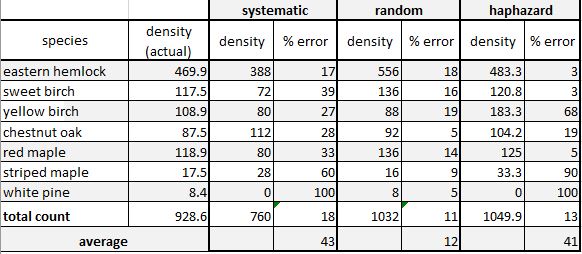User: | Open Learning Faculty Member:
In the virtual forest tutorial, the fastest estimated sampling time was using systematic sampling at 12.6 hours. Haphazard sampling was a close second with 12.61 hours, a negligible difference. Random sampling was estimated to take about 45 minutes longer at 13.4 hours. All area based samples were used.
Haphazard sampling was more accurate for common species, with the lowest percent error (eastern hemlock at 2.8% vs. 18% and 17%) (red maple at 5% vs. 14% and 33%). Random sampling was more accurate for rare species, with the lowest percent error (striped maple at 8.5 % vs. 60% and 90%) (white pine at 4.8% vs. 100% and 100%). Systematic and haphazard completely missed white pine counts.
The overall accuracy trend appears to change with species abundance as seen in the graph below (figure 1), with more abundant species showing less error when sampling density. Random sampling was the most accurate with the lowest average percent error of 12.3% versus systematic and haphazard being both greater than 40%. Random sampling seems to be much more precise over the entire range of density’s, maintaining accuracy at lower density values although requiring a longer sampling time (Table 1).


